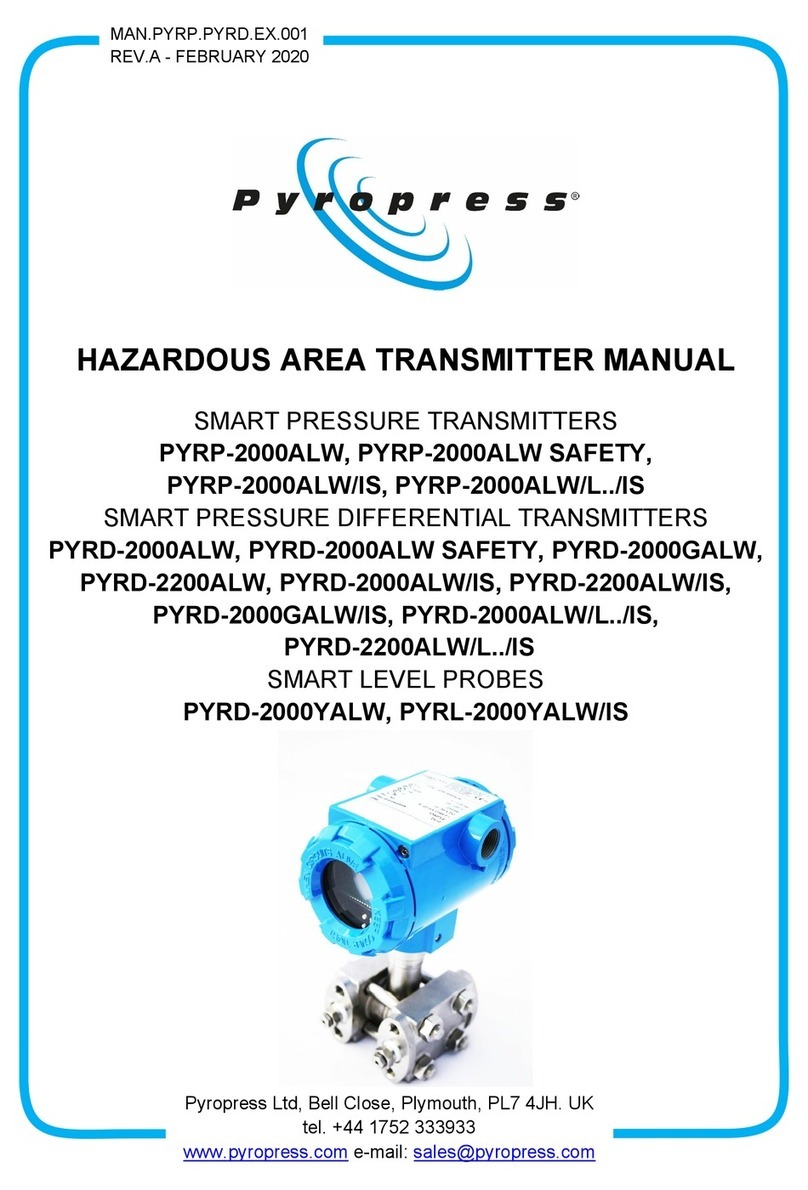DTR.PYRP.PYRD.PYRL-28
CONTENTS
1. INTRODUCTION............................................................................................................................................. 3
2. CONSIGNMENT CONTENTS.......................................................................................................................... 3
3. APPLICATIONS AND MAIN FEATURES........................................................................................................ 3
4. IDENTIFYING MARKS. ORDERING PROCEDURE ........................................................................................ 4
5. TECHNICAL DATA......................................................................................................................................... 4
5.1. PYRP–28. TECHNICAL DATA ....................................................................................................................... 4
5.1.1. PYRP–28. MEASUREMENT RANGES..........................................................................................................................4
5.1.2. PYRP–28. OPERATING PARAMETERS........................................................................................................................4
5.2. PYRD–28. TECHNICAL DATA ....................................................................................................................... 5
5.2.1. PYRD–28. MEASUREMENT RANGES..........................................................................................................................5
5.2.2. PYRD–28. OPERATING PARAMETERS .......................................................................................................................5
5.3. PYRP-28, PYRD-28.- COMMON PARAMETERS .............................................................................................. 5
5.3.1. PYRP–28, PYRD–28 .ELECTRICAL PARAMETERS....................................................................................................5
5.3.2. PYRP–28, PYRD–28. PERMITTED ENVIRONMENTAL CONDITIONS..............................................................................5
5.3.3. PYRP–28, PYRD–28. CONSTRUCTION MATERIALS...................................................................................................6
5.4. PRESSURE CONNECTORS............................................................................................................................. 6
5.4.1. PYRP–28. PRESSURE CONNECTORS.........................................................................................................................6
5.4.2. PYRD–28. PRESSURE CONNECTORS ........................................................................................................................6
5.5. PYRP–28,PYRD–28ELECTRICALCONNECTORSANDIPRATING.......................................................................... 6
6. CONSTRUCTION............................................................................................................................................ 6
6.1. MEASUREMENT PRINCIPLES ......................................................................................................................... 6
6.2. CONSTRUCTION........................................................................................................................................... 6
6.3. CASING,ELECTRICAL CONNECTIONS............................................................................................................. 7
7. INSTALLATION LOCATION OF TRANSMITTERS ......................................................................................... 8
7.1. GENERAL NOTE ........................................................................................................................................... 8
7.2. LOW AMBIENT TEMPERATURE....................................................................................................................... 8
7.3. HIGH PROCESS TEMPERATURES. .................................................................................................................. 8
7.4. MECHANICAL VIBRATION,CORROSIVE MEDIA................................................................................................. 8
8. INSTALLATION AND MECHANICAL CONNECTIONS................................................................................... 9
9. ELECTRICAL CONNECTION.......................................................................................................................... 9
9.1. GENERAL RECOMMENDATIONS...................................................................................................................... 9
9.2. CONNECTIONS FOR TRANSMITTERS WITH PD-TYPE CONNECTOR..................................................................... 10
9.3. CONNECTIONS FOR TRANSMITTERS WITH PK OR PM12-TYPE CONNECTOR...................................................... 10
9.4. CONNECTIONS FOR TRANSMITTERS WITH TERMINAL BOX (PZ-TYPE CONNECTOR)............................................. 10
9.5. PROTECTION FROM OVER VOLTAGE ............................................................................................................. 10
9.6. EARTHING................................................................................................................................................. 11
10. ZERO AND RANGE (SPAN) ADJUSTMENT............................................................................................... 11
11. SERVICES AND SPARE PARTS. ............................................................................................................... 11
11.1. PERIODIC SERVICE................................................................................................................................... 11
11.2. UNSCHEDULED SERVICES ......................................................................................................................... 11
11.3. CLEANING THE DIAPHRAGM AND OVERLOAD DAMAGE................................................................................. 11
11.4. SPARE PARTS.......................................................................................................................................... 12
12. PYRL-28 LEVEL PROBES.......................................................................................................................... 12
12.1. APPLICATIONS......................................................................................................................................... 12
12.2. PYRL–28. TECHNICAL DATA.................................................................................................................... 12
12.3. PRINCIPLES OF OPERATION,CONSTRUCTION.............................................................................................. 12
12.4. INSTALLATION AND FITTING ..................................................................................................................... 12
12.5. ELECTRICAL CONNECTION.SETTINGS ........................................................................................................ 13
12.6. EARTHING............................................................................................................................................... 13
13. PACKING, STORAGE AND TRANSPORT.................................................................................................. 13
14. GUARANTEE.............................................................................................................................................. 13
15. ADDITIONAL INFORMATION..................................................................................................................... 13
15.1. RELATED DOCUMENTS.............................................................................................................................. 13
15.2. RELATED STANDARDS.............................................................................................................................. 13
16. FIGURES (DIAGRAMS) .............................................................................................................................. 14
APPENDIX 01 (FOR INTRINSICALLY SAFE ATEX CERTIFIED VERSIONS) .................................................. 27




























